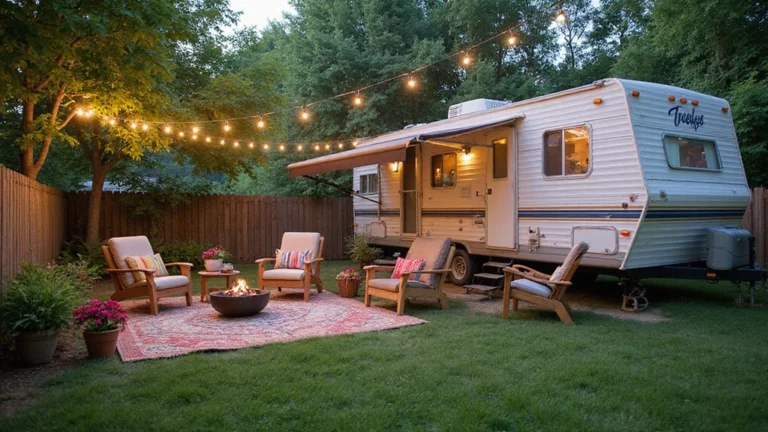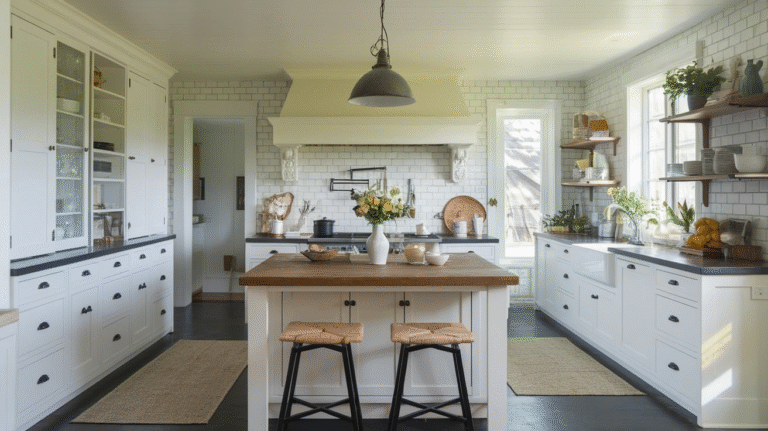19 Woodworking Shop Layout Ideas
Designing the perfect woodworking shop layout is like tuning an instrument—when everything is in the right place, the rhythm of your work just flows.
Every craftsman knows that an efficient shop doesn’t just make projects easier—it makes them enjoyable.
Whether you’re carving out space in a garage, basement, or dedicated workshop, the key is maximizing functionality, safety, and comfort.
Let’s explore 19 woodworking shop layout ideas that help you create a space that feels tailor-made for your projects and process.
1. Plan Your Workflow First
Before you move a single tool, think about your workflow. Every project follows three main stages—rough cutting, shaping, and assembly/finishing.
Your layout should reflect that natural progression. Place tools and workstations in a logical sequence so you’re not zigzagging across the shop like a lost hiker.
Start with your lumber storage near the entrance (for easy unloading), then the saws, planers, and jointers for cutting and shaping. Finally, keep your assembly table and finishing area farther in, away from dust-heavy machines. It’s like designing a production line—smooth, efficient, and effortless once it’s set up right.
2. Use the Golden Triangle Rule
Just as cooks swear by the “kitchen work triangle,” woodworkers benefit from their own version: the golden triangle of tools—the table saw, workbench, and jointer or planer. Arrange them within close reach to minimize wasted movement.
A 2023 study by Wood Magazine found that optimizing tool placement can reduce project time by 25% on average. That’s not just convenience—it’s efficiency that translates into more finished projects and less fatigue.
3. Maximize Natural Light and Ventilation
Good light isn’t a luxury—it’s essential. Position your main workbench near windows or natural light sources if possible. Natural light makes color matching and fine detail work more accurate. For ventilation, especially if you’re staining or sanding, cross-breeze windows or an exhaust fan are game-changers.
A well-ventilated shop doesn’t just keep air fresh; it also improves focus. Breathing in sawdust or fumes all day is not part of anyone’s dream shop plan.
4. Create Zones for Each Type of Work
Divide your shop into functional zones—cutting, assembly, finishing, and storage. This helps maintain order and minimizes clutter. In small shops, these zones might overlap, but even mental separation makes a big difference.
For instance, keep finishing materials far from sawdust-heavy areas to avoid contamination. Each zone should have its own designated tools and supplies—no more hunting for clamps when you’re knee-deep in a glue-up.
5. Invest in Smart Storage Solutions
Efficient storage turns chaos into creativity. Use pegboards, wall racks, and drawer organizers to keep your tools visible but tidy. Vertical space is your best friend—install shelves or cabinets up to the ceiling.
A statistic from Home Improvement Research Institute reports that the average DIYer spends 15 minutes per project just searching for tools. Multiply that by 50 projects a year, and you’re wasting over 12 hours just looking. Good storage isn’t just about neatness—it’s about saving time and sanity.
6. Optimize Electrical Outlets and Power Sources
Nothing kills workflow faster than extension cord spaghetti. Install multiple outlets at bench height and along each wall. Consider adding ceiling-mounted retractable cords for power tools in the middle of your shop.
If you’re running high-powered tools like a table saw or dust collector, ensure your wiring supports 20-amp circuits or even 220V lines. Proper planning here prevents overloading circuits and avoids constant plug juggling.
7. Dust Collection Is Non-Negotiable
Dust is the silent enemy of every woodworking shop. It clogs lungs, covers finishes, and creates fire hazards. Set up a centralized dust collection system with hoses running to your major tools. Even a compact shop vacuum with a cyclone separator can make a big difference.
According to OSHA, wood dust exposure affects over 600,000 woodworkers annually in the U.S. alone. Keeping dust under control isn’t just about cleanliness—it’s about your long-term health.
8. Keep a Central Workbench
Your workbench is the heart of the shop. Position it centrally so you have access from all sides. A sturdy bench with a vise or two, dog holes, and storage drawers underneath can serve multiple purposes—assembly, clamping, and even quick cutting.
Think of it as your command center—everything radiates outward from here. A mobile bench on locking casters gives flexibility for rearranging when projects demand extra space.
9. Use Mobile Bases for Large Tools
If your shop space is tight, mobility is your superpower. Mount heavy tools like table saws, planers, and drill presses on mobile bases. This allows you to roll them out when needed and tuck them away afterward.
It’s amazing how a few caster wheels can transform your workflow. You can reconfigure your shop in minutes to fit different projects—like rearranging furniture for a new dance.
10. Strategic Lumber and Sheet Storage
Lumber is both essential and bulky. Store sheet goods vertically to save floor space and make access easier. For boards, install horizontal wall racks sorted by wood type or size. Keep them close to your saw for convenience but far enough to avoid tripping hazards.
Humidity can warp your wood faster than you think—maintain proper climate control or use a dehumidifier to keep things stable year-round.
11. Sound Control and Comfort
The hum of machines might sound satisfying at first, but prolonged exposure can wear you down. Use acoustic panels, rubber mats, and soundproof insulation to soften the noise. A quieter shop means you can think clearly and even enjoy background music without cranking the volume.
Comfort matters too—anti-fatigue mats underfoot and a small stool at your bench will help you stay productive for hours without feeling like you’ve run a marathon.
12. Tool Accessibility and Ergonomics
Keep your most-used tools within arm’s reach of your workbench. Tools you rarely use can live on higher shelves or in drawers. Arrange tools by task—measuring, cutting, sanding—so your hands always know where to go next.
Ergonomics isn’t just for office chairs. Proper tool height and placement reduce strain on your back and shoulders, allowing you to focus on craftsmanship instead of discomfort.
13. Lighting That Works as Hard as You Do
Layered lighting is key. Combine overhead LEDs for general illumination with task lighting at benches and saws. Cool white light (4000K–5000K) gives the best color accuracy for finishing work.
A dark corner can hide mistakes, while proper lighting shows every grain and cut clearly. As any seasoned woodworker knows, seeing clearly means working confidently.
14. Safety Zones and Emergency Prep
Safety shouldn’t be an afterthought. Designate a clear walking path free of cords or debris. Keep a first aid kit, fire extinguisher, and emergency shutoff switch within easy reach.
The U.S. Consumer Product Safety Commission reports over 30,000 woodworking-related injuries annually. A smart layout minimizes risk. Think of safety zones around saws and tools—enough room to maneuver without bumping into anything.
15. Climate Control and Insulation
If your shop sits in a garage or basement, temperature swings can mess with both you and your materials. Add insulation, a space heater, or a mini-split air conditioner to stabilize conditions.
Stable temperatures prevent warping and glue failure. More importantly, they keep you working year-round instead of hibernating every winter.
16. Dedicated Finishing Area
Finishing deserves its own zone—dust-free, well-ventilated, and clean. Use plastic curtains or a partition wall to separate it from sawdust-heavy areas. A simple setup with good lighting, drying racks, and shelves for finishes goes a long way.
Having this dedicated space saves countless hours of frustration spent picking dust specks out of wet varnish—a battle every woodworker fights at least once.
17. Space for Jigs and Fixtures
Jigs and fixtures multiply efficiency but also multiply clutter if not managed. Dedicate a wall rack or shelving section to them, labeled and easily accessible. Hanging them vertically keeps shapes visible and prevents damage.
Over time, your collection will grow like old friends who each solve a unique problem—keep them organized, and they’ll always have your back.
18. Include a Design or Planning Corner
Even a small corner with a desk, laptop, and sketchpad can make a huge difference. Use it to design projects, write measurements, or manage tool maintenance logs.
A woodworking layout isn’t complete without a mental workspace. The best ideas often come when you step back and plan instead of jumping straight into the sawdust.
19. Personalize and Evolve Your Space
Your shop should evolve with you. As your skills grow, rearrange, add new stations, or retire tools that no longer serve you. Hang up a few personal touches—photos, quotes, or that first successful project you ever built.
A woodworking shop isn’t just a workspace—it’s a living reflection of your journey. You’ll know it’s right when stepping into it feels like stepping into your own rhythm.
Conclusion on 19 Woodworking Shop Layout Ideas
Designing your woodworking shop layout isn’t just about fitting tools into a room—it’s about creating a space that fuels creativity and productivity. A well-planned shop makes work safer, faster, and more enjoyable. The ideal layout balances three essentials: workflow efficiency, comfort, and adaptability.
From the golden triangle of tools to dust control, lighting, and zoning, every decision shapes how smoothly your projects come to life. Don’t rush it—experiment, adjust, and listen to how the space feels. As any woodworker knows, perfection comes through patience and precision.
In the end, the perfect shop layout is one that feels like a natural extension of your hands and mind. When every tool is where you expect it, when movement feels effortless, and when the air smells faintly of sawdust and satisfaction—that’s when you’ve built more than a workshop. You’ve built your creative sanctuary.




